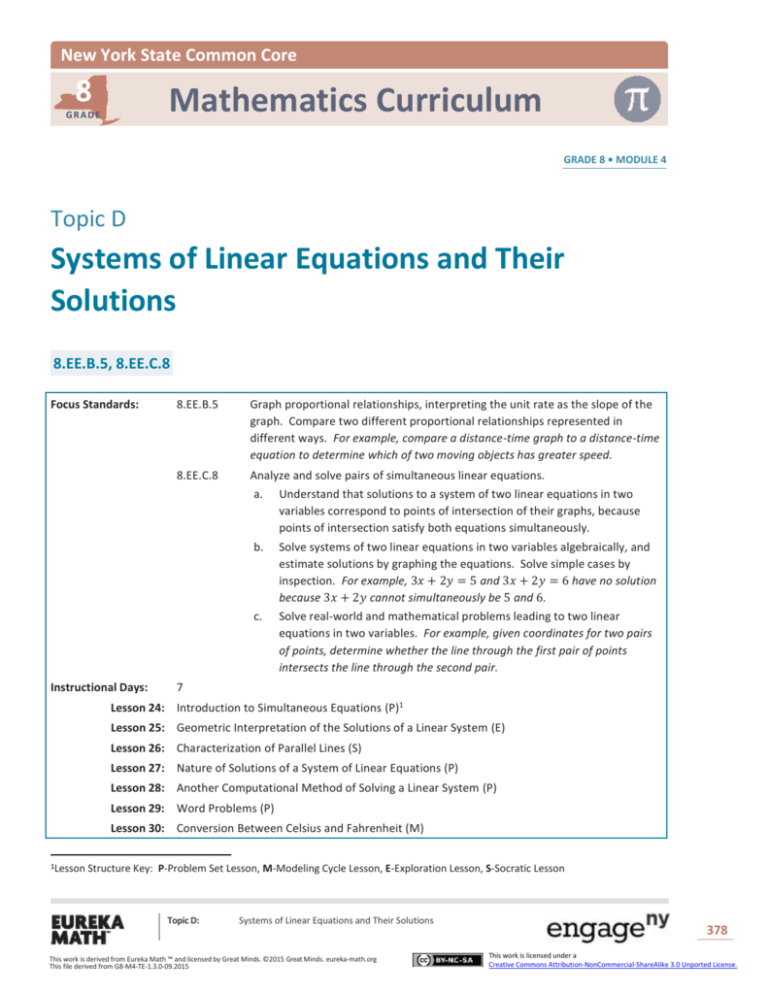Grade 8 Mathematics Module 4, Topic D, Overview
advertisement

New York State Common Core 8 Mathematics Curriculum GRADE GRADE 8 • MODULE 4 Topic D Systems of Linear Equations and Their Solutions 8.EE.B.5, 8.EE.C.8 Focus Standards: Instructional Days: 8.EE.B.5 Graph proportional relationships, interpreting the unit rate as the slope of the graph. Compare two different proportional relationships represented in different ways. For example, compare a distance-time graph to a distance-time equation to determine which of two moving objects has greater speed. 8.EE.C.8 Analyze and solve pairs of simultaneous linear equations. a. Understand that solutions to a system of two linear equations in two variables correspond to points of intersection of their graphs, because points of intersection satisfy both equations simultaneously. b. Solve systems of two linear equations in two variables algebraically, and estimate solutions by graphing the equations. Solve simple cases by inspection. For example, 3𝑥 + 2𝑦 = 5 and 3𝑥 + 2𝑦 = 6 have no solution because 3𝑥 + 2𝑦 cannot simultaneously be 5 and 6. c. Solve real-world and mathematical problems leading to two linear equations in two variables. For example, given coordinates for two pairs of points, determine whether the line through the first pair of points intersects the line through the second pair. 7 Lesson 24: Introduction to Simultaneous Equations (P)1 Lesson 25: Geometric Interpretation of the Solutions of a Linear System (E) Lesson 26: Characterization of Parallel Lines (S) Lesson 27: Nature of Solutions of a System of Linear Equations (P) Lesson 28: Another Computational Method of Solving a Linear System (P) Lesson 29: Word Problems (P) Lesson 30: Conversion Between Celsius and Fahrenheit (M) 1Lesson Structure Key: P-Problem Set Lesson, M-Modeling Cycle Lesson, E-Exploration Lesson, S-Socratic Lesson Topic D: Systems of Linear Equations and Their Solutions This work is derived from Eureka Math ™ and licensed by Great Minds. ©2015 Great Minds. eureka-math.org This file derived from G8-M4-TE-1.3.0-09.2015 378 This work is licensed under a Creative Commons Attribution-NonCommercial-ShareAlike 3.0 Unported License. NYS COMMON CORE MATHEMATICS CURRICULUM Topic D 8•4 Topic D introduces students to systems of linear equations by comparing distance-time graphs to determine which of two objects has greater speed (8.EE.B.5, 8.EE.C.8c). Lessons 25–27 expose students to the possibilities for solutions of a system of linear equations. In Lesson 25, students graph two linear equations on a coordinate plane and identify the point of intersection of the two lines as the solution to the system (8.EE.C.8a). Next, students look at systems of equations that graph as parallel lines (8.EE.C.8b). In Lesson 26, students learn that a system can have no solutions because parallel lines do not have a point of intersection (8.EE.C.8b). Lesson 27 continues this thinking with respect to systems that have infinitely many solutions (8.EE.C.8b). In Lesson 28, students learn how to solve a system of equations using computational methods, such as elimination and substitution (8.EE.C.8b). In Lesson 29, students must use all of the skills of the module to transcribe written statements into a system of linear equations, find the solution(s) if it exists, and then verify that it is correct. Lesson 30 is an application of what students have learned about linear equations. Students develop a linear equation that represents the conversion between temperatures in Celsius to temperatures in Fahrenheit. Topic D: Systems of Linear Equations and Their Solutions This work is derived from Eureka Math ™ and licensed by Great Minds. ©2015 Great Minds. eureka-math.org This file derived from G8-M4-TE-1.3.0-09.2015 379 This work is licensed under a Creative Commons Attribution-NonCommercial-ShareAlike 3.0 Unported License.









